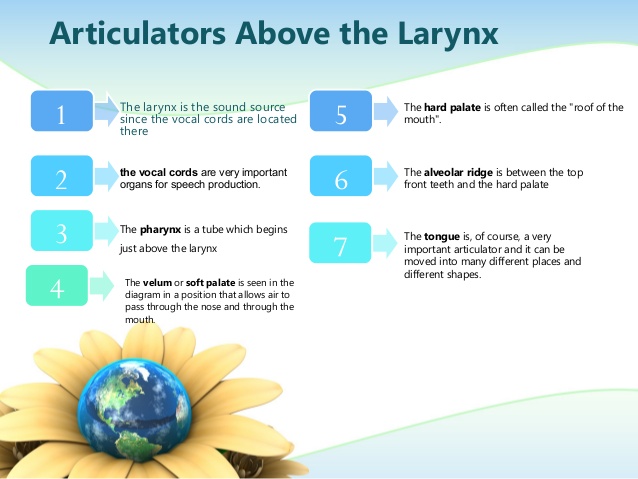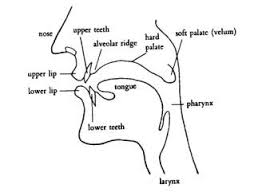Phonetics
| Site: | Plateforme pédagogique de l'Université Sétif2 |
| Cours: | phonetics |
| Livre: | Phonetics |
| Imprimé par: | Visiteur anonyme |
| Date: | vendredi 24 octobre 2025, 10:03 |
Description

1. Articulators Above the Larynx

All the sounds we make when we speak are the result of muscles contracting. muscles in the larynx produce many different modifications in the flow of air from the chest to the mouth. After passing through the larynx, the air goes through what we call the vocal tract, which ends at the mouth and nose; we call the part comprising the mouth the oral cavity and the part that leads to the nose the nasal cavity. Here the air from the lungs escapes into the atmosphere. We have a large and complex set of muscles that can produce changes in the shape of the vocal tract, and in order to learn how the sounds of speech are produced it is necessary to become familiar with the different parts of the vocal tract. These different parts are called articulators, and the study of them is called articulatory phonetics.
1.1. Articulators just above the Larynx
The lungs are the first source of the which will be pushed directly through the larynx.
1)The vocal cords (the vocal folds) are cords capable of moving. They exist within the larynx. They have three main actions:
a-Vibrating for voiced sounds: zzzzzz
b-Not vibrating for voiceless sounds: sssss
c-Stopped for the glottal stop: wa?er-water
The space between the vocal cords is referred to as the glottis
2) The pharynx is a tube which begins just above the larynx. It is about 2 cm long in women and about 5 cm in men, and at its top end it is divided into two parts, one part being the back of the oral cavity and the other being the beginning of the way through the nasal cavity. If you look in your mirror with your mouth open, you can see the back of the pharynx.
1.2. Articulators within the Mouth

1) The soft palate or velum is seen in the diagram in a position that allows air to pass through the nose and through the mouth. Yours is probably in that position now, but often in speech it is raised so that air cannot escape through the nose. The other important thing about the soft palate is that it is one of the articulators that can be touched by the tongue. When we make the sounds k, g the back of the tongue is in contact with the lower side of the soft palate, and we call these velar consonants.
2) The hard palate is often called the "roof of the mouth". You can feel its smooth curved surface with your tongue. A consonant made with the front of the tongue close to the hard palate is called palatal. The sound j in 'yes' is palatal.
In addition, the tip of the tongue may also articulate with the hard palate, where it turns backwards creating the retroflex consonant ‘r’
3) The alveolar ridge is between the top front teeth and the hard palate. You can feel its shape with your tongue. Its surface is really much rougher than it feels, and is covered with little ridges. You can only see these if you have a mirror small enough to go inside your mouth, such as those used by dentists. Sounds made with the tip or blade of the tongue touching here (such as t, d, n, s, z) are called alveolar.
4) The tongue is a very important articulator and it can be moved into many different places and different shapes. It is usual to divide the tongue into different parts, though there are no clear dividing lines within its structure. The tongue on a larger scale with these parts shown: tip, blade, front, back and root.
-The very back of the tongue may be drawn backwards coming close to the pharynx to make the pharyngal sound: h
-The back of the tongue can articulate with the soft palate to produce velar sounds: k,g
- The front of the tongue can come close to the hard palate creating a palatal consonant: j
- The tip of the tongue may also articulate with the hard palate for the production of the retroflex: r
- The tip or blade of the tongue may touch the alveolar ridge to produce alveolar sounds: t, d
-The tip of the tongue can articulate with the upper teeth for dental sounds: θ, ð
5) The teeth (upper and lower) only at the front of the mouth, immediately behind the lips. This is for the sake of a simple diagram, and you should remember that most speakers have teeth to the sides of their mouths, back almost to the soft palate. The tongue is in contact with the upper side teeth for most speech sounds. Sounds made with the tongue touching the front teeth, such as English θ, ð , are called dental.
6) The lips are important in speech. They can be pressed together (when we produce the sounds p, b), brought into contact with the teeth (as in f, v), or rounded to produce the lip-shape for vowels like u:. Sounds in which the lips are in contact with each other are called bilabial, while those with lip- to-teeth contact are called labiodental.